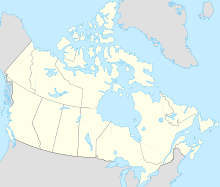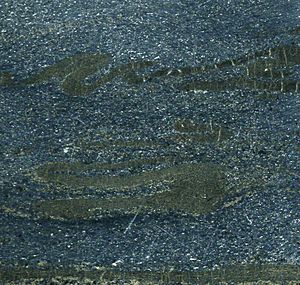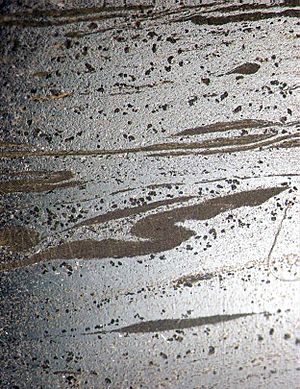Sullivan Mine facts for kids
| Location | |
|---|---|
| Location | Kimberley |
| Province | British Columbia |
| Country | Canada |
| Coordinates | 49°41′18″N 115°59′19″W / 49.688312°N 115.988687°W |
| Production | |
| Products | |
| History | |
| Opened | 1909 |
| Closed | 2001 |
| Owner | |
| Company | Teck Cominco |
| Website | Sullivan Mine |
The Sullivan Mine was a large underground mine located in Kimberley, British Columbia, Canada. It was a place where valuable metals like zinc, lead, silver, and tin were found. These metals were hidden deep inside rocks that formed on the ancient seafloor.
The mine was discovered in 1892. In 1909, a company called Consolidated Mining and Smelting Company of Canada bought it. This company later became Cominco Ltd. and then Teck Cominco.
A big reason for the mine's success was a new method developed in 1916. This method, called "differential flotation," allowed miners to separate lead and zinc from the ore. This made it much easier to get the pure metals. This new technology was so good that it was later used all over the world!
Over its 92 years of operation, the Sullivan Mine produced a huge amount of metals. It dug up over 160 million tons of rock. From this, it produced 8 million tons of lead, 7 million tons of zinc, and 285 million ounces of silver. All these metals were worth more than $20 billion!
The Sullivan Mine closed in 2001. Since then, Teck Cominco has been working to clean up the site. They are making sure the land is safe and healthy again.
What is a SedEx Deposit?
The Sullivan Mine was a special type of mine called a "sedimentary exhalative (SedEx) deposit." This means the metals formed in sedimentary rocks on the bottom of an ancient ocean.
Imagine hot, salty water (called "brines") flowing up from deep inside the Earth. These brines carried tiny bits of metals. When they reached the seafloor, they mixed with sulfur from the ocean water. This caused the metals to combine with sulfur, forming solid sulfide minerals. These minerals then settled on the seafloor, creating the rich ore body.
This process happened about 1470 million years ago! That's a very long time ago, during a period called the Precambrian era. Over millions of years, the rocks and minerals changed due to heat and pressure, but the valuable metals remained.




